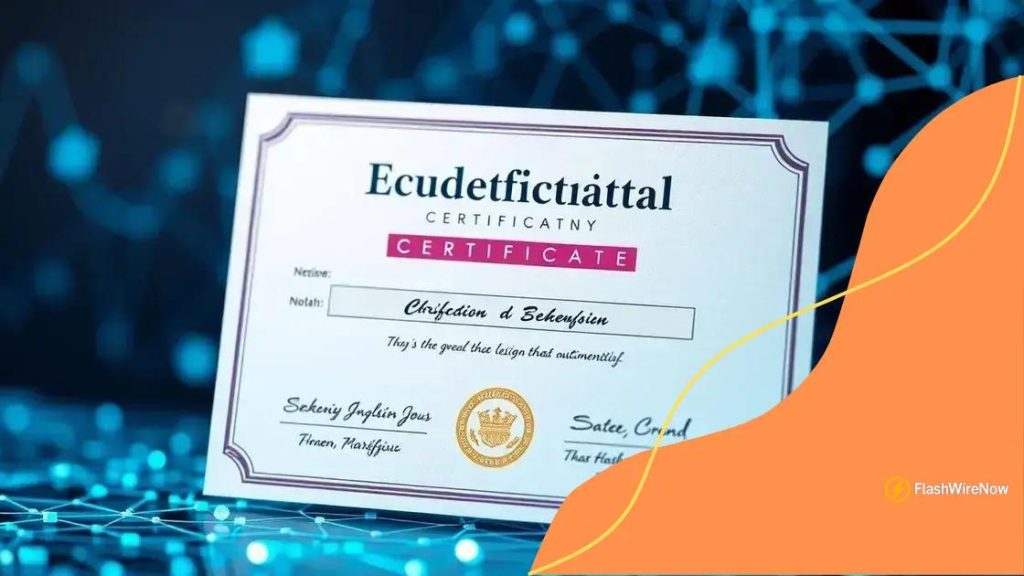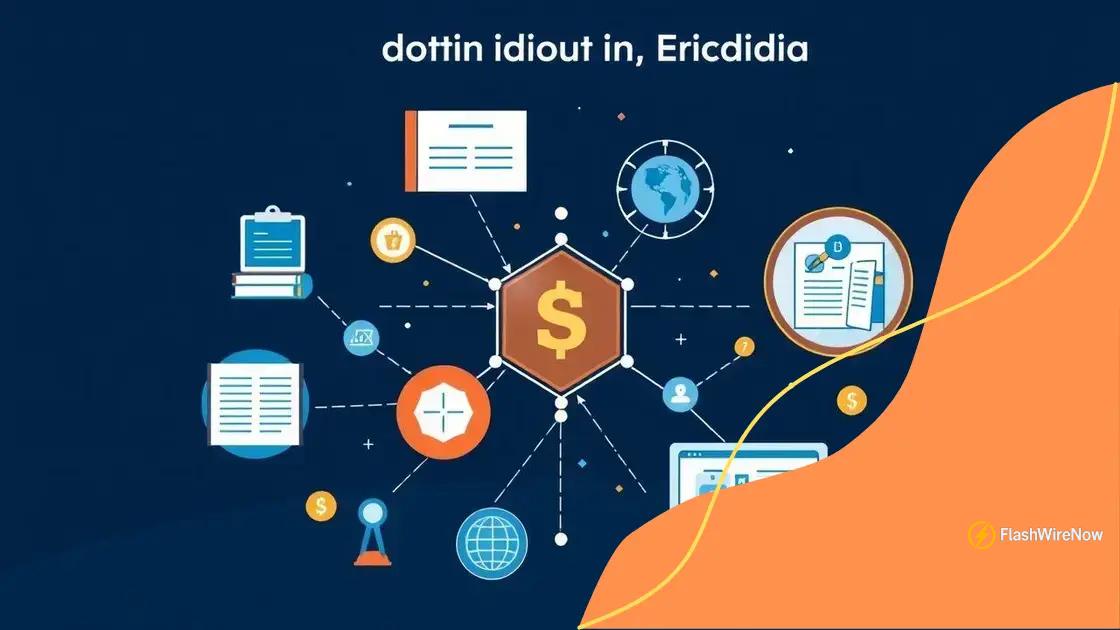Blockchain for transcript verification: ensuring authenticity

Anúncios
Blockchain technology enhances transcript verification by providing secure, tamper-proof records, streamlining the verification process, and offering students control over their educational credentials.
Blockchain for transcript verification is transforming the way institutions authenticate academic credentials. Curious about how this technology can revolutionize trust in education? Let’s dive into its potential!
Anúncios
Understanding blockchain technology
Understanding blockchain technology is essential for grasping its role in transcript verification. At its core, blockchain is a decentralized digital ledger that securely records transactions across multiple computers. This ensures that the data stored cannot be altered retroactively, providing a high level of security.
The uniqueness of blockchain lies in its transparency and immutability. Each participant in the network has access to the same information, which helps to build trust among users. Additionally, once a block is added to the chain, it becomes nearly impossible to change without altering all subsequent blocks, which requires consensus from the majority of the network.
Key Features of Blockchain
Here are some of the defining characteristics of blockchain technology:
Anúncios
- Decentralization: No single entity controls the entire blockchain, enhancing security.
- Transparency: All participants can view the data, making it easier to verify transactions.
- Immutability: Data entries are permanent and cannot be changed without consensus.
- Security: Strong cryptography protects data from unauthorized access.
The combination of these features makes blockchain an appealing solution for industries that require fraud prevention, such as education. By using blockchain for transcript verification, educational institutions can ensure that the documents they issue are authentic and tamper-proof.
As interest in this technology grows, many organizations are exploring its potential applications. From simplifying administrative processes to enhancing security, the benefits of blockchain are significant. Moreover, the increasing collaboration among experts and institutions will likely lead to more innovative uses of blockchain in the near future.
Understanding the basics of blockchain technology sets the stage for exploring how it can transform transcript verification. By grasping these foundational concepts, users will be better equipped to appreciate the practical applications of this cutting-edge technology.
How blockchain enhances transcript verification
Blockchain significantly enhances transcript verification by ensuring authenticity and security. Through its unique structure, it provides a reliable way to verify educational documents without the fear of tampering.
One of the major benefits of using blockchain is the ability to create a permanent and unchangeable record of transcripts. Once a transcript is issued and added to the blockchain, it cannot be altered or deleted. This feature protects students and institutions by preventing fraud and verifying that a document is genuine.
The Role of Smart Contracts
Blockchain employs smart contracts to automate transcript verification processes. These contracts are self-executing agreements with the terms directly written into code. In the context of transcript verification, they streamline operations in the following ways:
- Automated Verification: Smart contracts can automatically verify the validity of a transcript.
- Efficiency: This reduces the time needed for manual checks and speeding up the process.
- Cost-Effective: By minimizing administrative work, schools save money.
Moreover, the transparency of blockchain technology allows all parties involved, including students, universities, and employers, to view the same information. This shared visibility fosters trust and confidence. Employers, for instance, can easily access verified transcripts to confirm a candidate’s qualifications.
Another key advantage is the enhanced accessibility of records. Students can have control over their educational data, giving them easy access to their transcripts without needing to contact their institution each time. This empowerment enhances the overall student experience.
As educational institutions increasingly recognize the benefits, many are beginning to integrate blockchain solutions into their systems. This shift not only modernizes transcript verification but also sets a new standard for security and authenticity in education.
Real-world applications of blockchain in education

Real-world applications of blockchain in education are transforming how institutions manage data and verify credentials. Many schools and universities are starting to harness blockchain technology to improve efficiency and security.
One primary use of blockchain is in managing student records. By storing academic achievements on a blockchain, schools can ensure that these records are secure and easily accessible. This fosters trust among all parties involved—students, parents, and employers alike.
Key Applications of Blockchain in Education
Here are some notable ways that blockchain is being used in educational settings:
- Transcript Verification: Institutions can securely issue digital diplomas and transcripts. This prevents fraud and allows employers to instantly verify educational credentials.
- Credentialing: Blockchain can provide a permanent record of qualifications, certifications, and training received by an individual.
- Decentralized Learning Platforms: Online learning can benefit from blockchain by providing verifiable records of completed courses, improving recognition of online education.
Blockchain also supports transparency in funding and scholarship programs. For example, it can track the distribution of funds, ensuring that money goes directly to the intended recipients. This accountability helps restore confidence in financial operations within educational institutions.
Furthermore, blockchain enables the creation of digital identities for students. These identities allow learners to manage their academic records and share them safely with potential employers or institutions. By controlling their data, students feel more empowered in their educational journeys.
In summary, the real-world applications of blockchain in education are vast and varied. As technology continues to evolve, the potential for improvements in transparency, security, and efficiency within the educational sector grows.
Challenges of blockchain adoption in transcript verification
The adoption of blockchain in transcript verification presents several challenges that institutions must navigate. While the benefits of enhanced security and transparency are clear, implementing this technology requires careful consideration.
One significant challenge is the initial cost associated with adopting blockchain technology. Institutions often face high expenses related to infrastructure upgrades, training, and system integration. This can deter schools, especially smaller ones, from making the shift.
Technical Complexity
Another barrier is the technical complexity of blockchain systems. To effectively implement a blockchain solution, institutions need skilled professionals who understand blockchain technology. This shortage of expertise can slow down the adoption process.
Additionally, many educational institutions are tied to legacy systems. Integrating blockchain with these existing systems can be complicated and time-consuming. Many stakeholders in the education sector may also have concerns regarding data privacy and compliance with regulations.
Resistance to Change
Resistance to change is another hurdle. Some educators and administrators might be hesitant to trust new technologies over traditional methods. They may worry about the reliability of a blockchain system without fully understanding its advantages.
Furthermore, the current regulatory landscape poses challenges. Many governments and organizations do not yet have clear guidelines regarding blockchain use in education. This uncertainty can make institutions cautious in their adoption efforts.
Despite these challenges, many institutions are exploring pilot programs and collaborations to test blockchain applications. This cautious approach allows them to evaluate the technology’s effectiveness before committing long-term.
Future trends in blockchain and education
Future trends in blockchain and education are set to reshape the way academic institutions handle data and credentials. As technology continues to evolve, the integration of blockchain into educational systems will likely expand.
One emerging trend is the increased use of decentralized platforms for learning. These platforms utilize blockchain to provide secure, verifiable credentials and allow learners more control over their educational records. A shift toward learner-centric models is expected, where individuals can manage their achievements and share them with employers easily.
Personalized Learning Experiences
Another significant trend is the customization of learning experiences. Blockchain can facilitate personalized education by securely storing individualized learning paths and progress. Educators can tailor programs based on a learner’s unique needs, enhancing engagement and outcomes.
Blockchain technology is also likely to pave the way for innovative funding models in education. For instance, institutions could utilize cryptocurrency for tuition payments, breaking down traditional barriers and making education more accessible.
Collaboration and Data Sharing
Collaboration between educational institutions and technology companies is anticipated to increase. By working together, they can develop solutions that harness the full potential of blockchain. This collaboration may result in standardized protocols that enhance interoperability between different educational systems.
Furthermore, as governments and organizations formulate regulations around blockchain usage, clarity will emerge regarding best practices for educational applications. This will instill greater confidence in implementing blockchain solutions and drive wide-scale adoption.
In addition to these trends, there may be a rise in awareness about the importance of digital literacy. Educators and students alike will need to understand how blockchain works and its implications in academia. This knowledge will be crucial as technological advancements continue to shape educational landscapes.
FAQ – Frequently Asked Questions about Blockchain in Education
What is blockchain technology?
Blockchain is a decentralized digital ledger that securely records transactions across multiple computers, making data tampering nearly impossible.
How does blockchain enhance transcript verification?
Blockchain ensures that transcripts are secure and immutable, allowing for quick and reliable verification of educational credentials.
What are the main challenges of implementing blockchain in education?
Challenges include high implementation costs, technical complexity, and resistance to change from traditional methods.
What future trends can we expect in blockchain and education?
Future trends include personalized learning experiences, decentralized platforms, and increased collaboration between educational institutions and tech companies.





